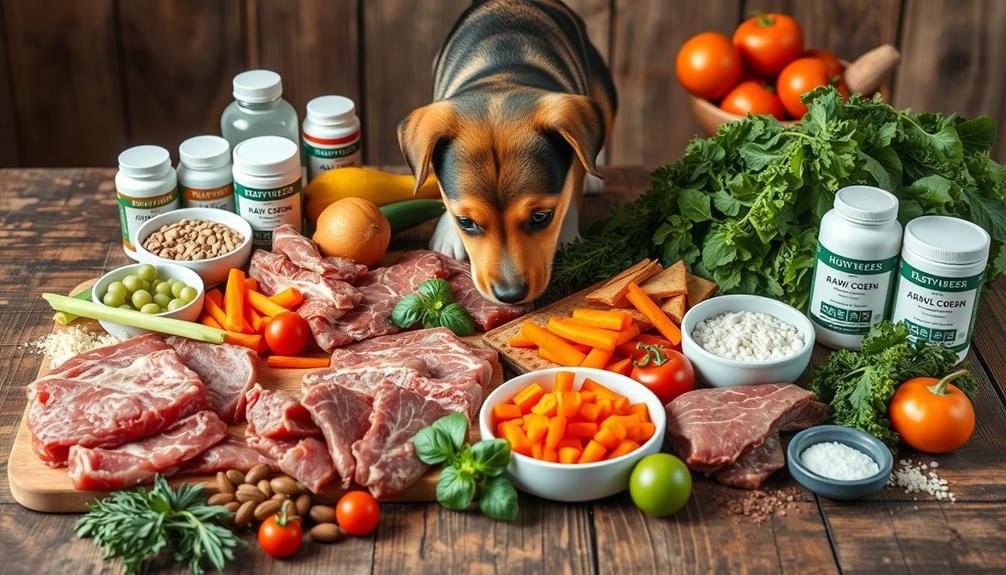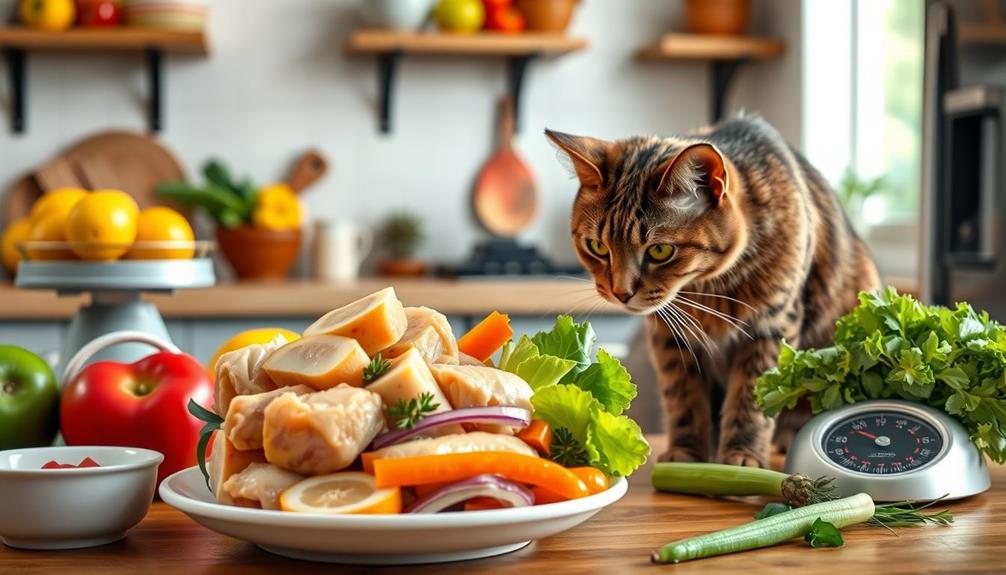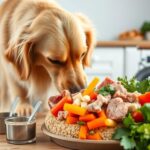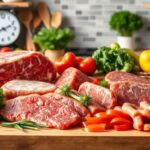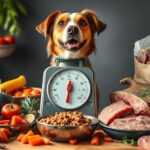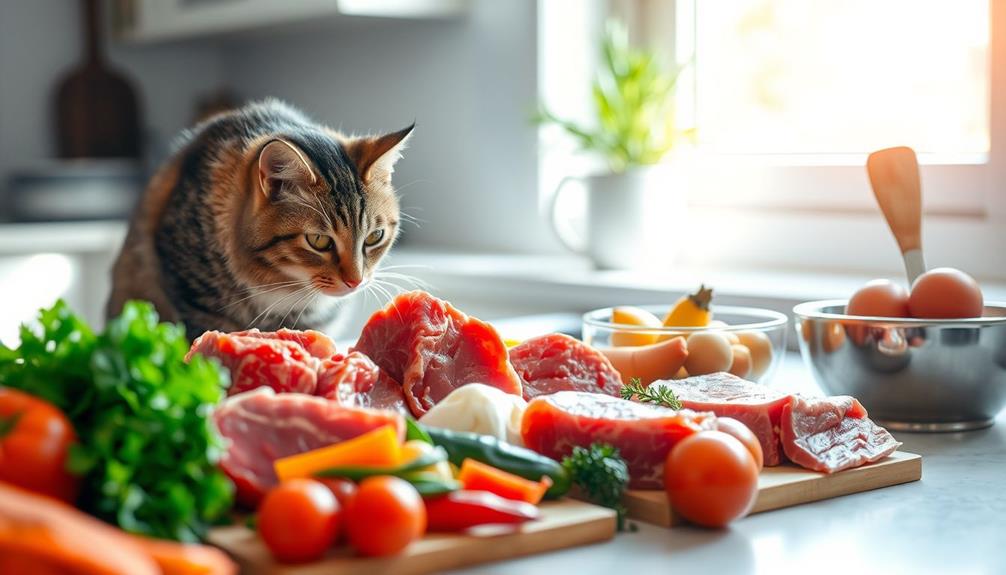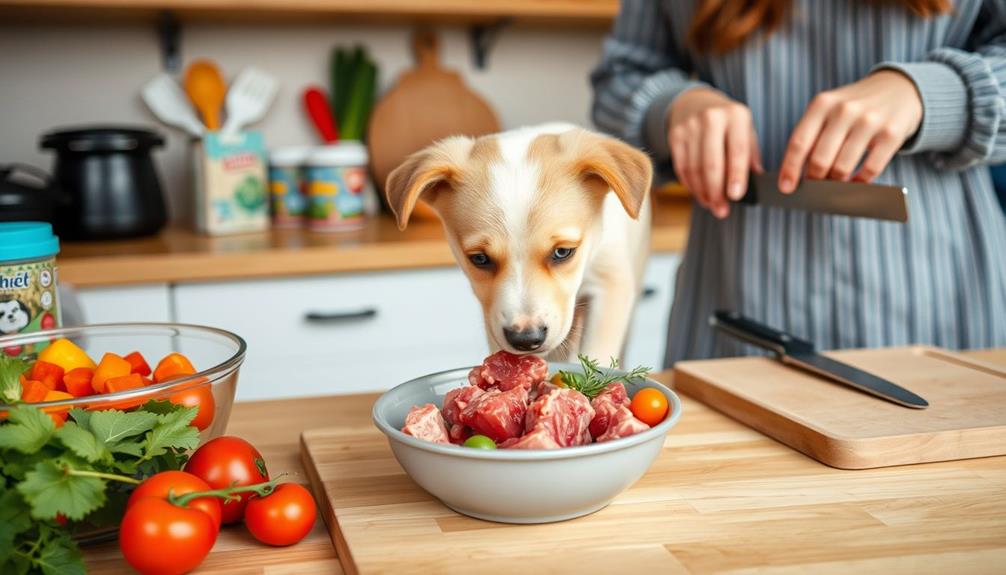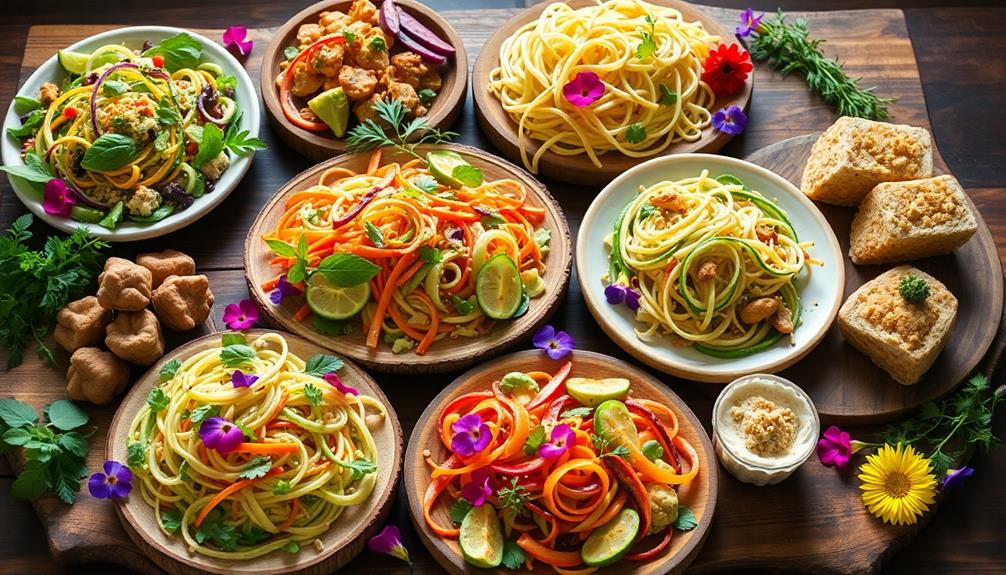To determine how much raw food to feed your dog, use their weight as a guide. Adult dogs typically need about 2% to 4% of their body weight daily, while puppies require 5% to 10%. Adjust based on their activity level: active dogs may need closer to 3%. For example, a 50-pound dog needs around 1 to 1.5 pounds daily. Divide this into two meals for adults or two to three for puppies. Always monitor their response and adjust based on changes in weight and energy levels. Keep exploring to understand the best practices for shifting to a raw diet! When transitioning to a raw food diet, it’s important to consider the raw food cost breakdown. While raw feeding can be more expensive than traditional dog food, many pet owners find it to be worth the investment for their pet’s health and well-being. To manage costs, consider buying in bulk or finding a local raw food co-op. And don’t forget to factor in the cost of any necessary supplements or additional veterinary care that may be required when making the switch.
Key Takeaways
- Adult dogs should receive 2% to 4% of their body weight in raw food daily, adjusted for activity levels.
- Puppies require 5% to 10% of their body weight in raw food, divided into 2-3 meals daily.
- Monitor weight, stool quality, and energy levels to adjust food portions as needed during the transition to a raw diet.
- Gradually introduce raw food by starting with 25% raw and increasing to 100% over two weeks to prevent digestive upset.
- Choose high-quality, hormone-free ingredients and ensure a balanced mix of muscle meat, organ meat, and bone for optimal nutrition.
Benefits of a Raw Diet
When you consider your dog's health, a raw diet can offer a range of impressive benefits. One of the most noticeable advantages is the shinier coat your dog will likely develop. This improvement often goes hand-in-hand with better skin health, helping to reduce allergies and other skin issues.
Additionally, many pet owners report that their dogs experience improved behavior and reduced anxiety levels when fed a more natural diet, which can be linked to better overall health and well-being. You may also notice your dog has enhanced energy levels and overall vitality, leading to a better quality of life.
Another key benefit of raw feeding is better dental health. The natural chewing involved with raw foods helps reduce plaque buildup, keeping your dog's teeth cleaner and gums healthier.
You'll appreciate how a raw diet promotes improved nutrient absorption, resulting in smaller, firmer stools that indicate efficient digestion. This is reminiscent of the importance of proper diet in small pets, as seen in ultimate hamster care, emphasizing the role of nutrition in overall health.
Even if you start with just a 25% addition of raw food to your dog's diet, you can see significant benefits of raw feeding. These can include fewer allergy symptoms and improved overall comfort for your furry friend.
Shifting to a raw diet could be one of the best choices you make for your dog's health and happiness.
Portion Guidelines for Dogs
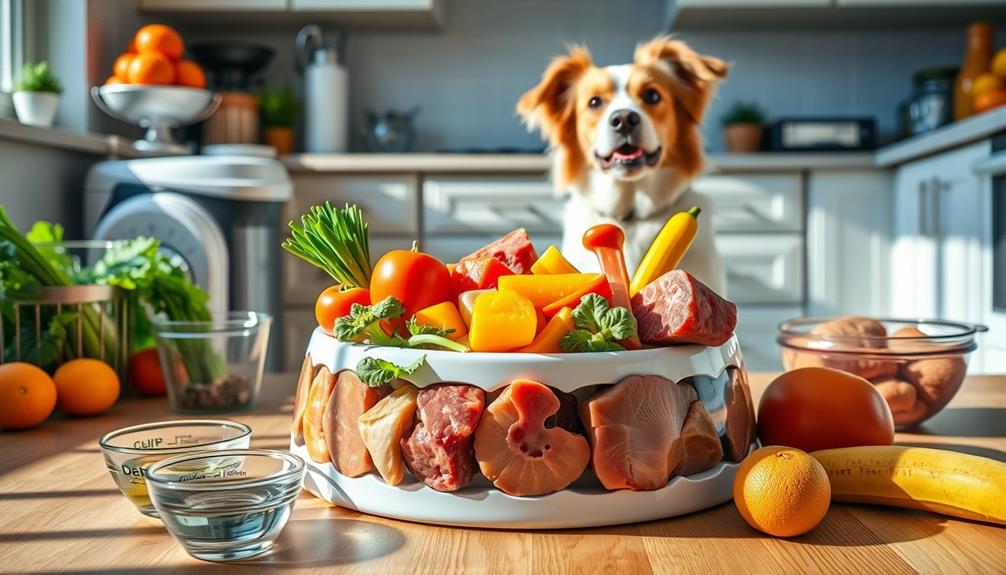
When deciding how much raw food to feed your dog, you'll want to take into account their weight and activity level.
Understanding the significance of long-term planning for your dog's health and diet can be beneficial, as it sets the foundation for their overall well-being.
Generally, adult dogs need 2% to 4% of their body weight in food daily, while smaller dogs might require a higher percentage.
Additionally, adjusting portion sizes for puppies and feeding frequency is essential for their growth and health.
For more insights, check out financial considerations for elderly care.
Recommended Portion Percentages
Determining the right portion sizes for your dog is vital to guarantee they maintain a healthy weight and receive adequate nutrition. For adult dogs, it's typically recommended to feed 2% to 4% of their body weight daily, depending on their activity level. Smaller dogs under 5 lbs may require up to 6%, while more active dogs usually need around 3% of their ideal weight. Dogs at their ideal weight generally require 2% to 2.5%.
It's also important to divide daily portions into two meals. For example, a 50-pound dog would need approximately 1 to 1.5 pounds of raw food daily. Here's a quick reference table to help you visualize the recommended portion percentages:
| Dog Size | Recommended Amount |
|---|---|
| Under 5 lbs | Up to 6% of body weight |
| 5-20 lbs | 5% of body weight |
| 21-50 lbs | 2% to 3% of body weight |
| Over 50 lbs | 2% to 2.5% of body weight |
For puppies, you should feed 5% to 10% of their body weight daily, split across multiple meals for ideal growth and development.
Adjusting for Activity Levels
Adjusting the amount of raw food your dog needs can depend considerably on their activity level. If your dog is highly active, they typically require about 3% of their ideal body weight in raw food daily. For dogs at an ideal weight, this drops to around 2-2.5%.
Smaller dogs have different needs; for instance, those up to 5 lbs might need 5-6%, while dogs between 15-19 lbs usually require 2.5-3%. Offering healthy snacks in addition to their raw food can also provide essential nutrients and keep them engaged.
It's vital to monitor your dog's weight closely. If you notice any weight loss or gain, you'll need to adjust their food intake accordingly. The high nutrient bioavailability of a raw dog food diet often means you can feed smaller portions compared to kibble, so pay attention to how your dog responds to their food.
To better mimic natural feeding patterns and aid digestion, consider splitting your dog's daily portion into two meals. This approach not only helps in adjusting for activity levels but also guarantees your dog gets the most out of their raw diet.
Feeding Frequency Guidelines
To guarantee your dog thrives on a raw food diet, it's essential to establish a consistent feeding frequency. For adult dogs, you should feed them 2-4% of their body weight daily. Smaller dogs typically need a higher percentage, while larger breeds require the lower end of that range.
It's important to take into account factors such as your dog's developmental milestones and overall activity level when determining their dietary needs. Most dog owners prefer splitting this into two meals per day, which helps maintain energy levels and aids digestion.
If you have a puppy, the feeding frequency is slightly different. Puppies should eat 2-3 times a day, with each meal consisting of about 10% of their current weight or 2-3% of their ideal adult weight.
Keep in mind that active dogs may require an increased food intake, so adjust the amount of raw dog food closer to 3% of their ideal weight.
The raw food diet provides higher nutrient bioavailability, meaning you can offer smaller meal sizes without compromising nutrition. Always pay attention to your dog's weight and adjust their meals accordingly, ensuring you're meeting their individual needs and health requirements.
Consistency in feeding will help your dog thrive on their raw food journey.
Starting a Raw Diet
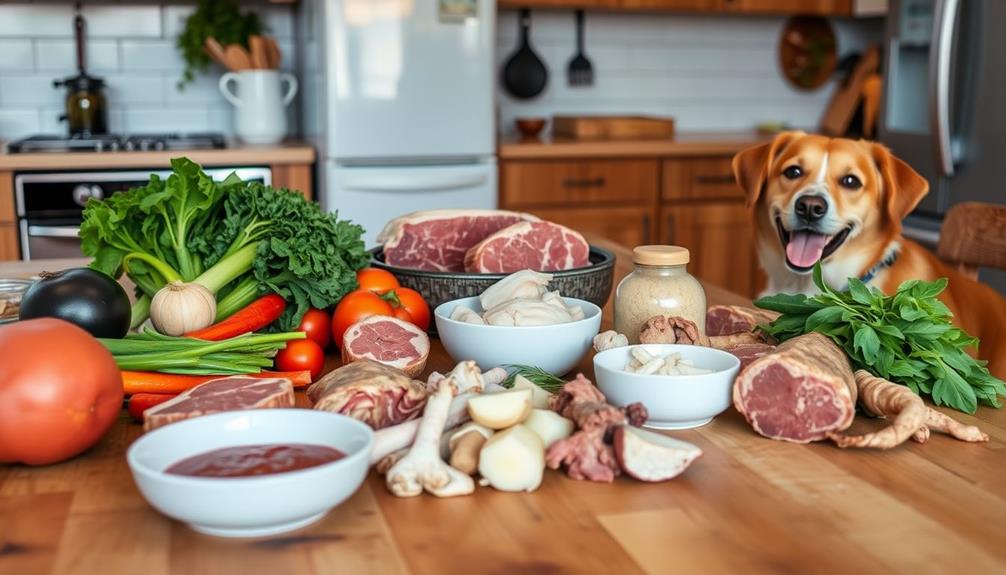
When you start a raw diet for your dog, it's vital to shift slowly to avoid digestive upset.
Beginning with a mix of 25% raw food and 75% of their current diet over about 13 days is important, as sudden changes can lead to gastrointestinal discomfort.
Monitor how your dog responds during this shift, especially for signs of gastrointestinal issues.
Adjust their intake based on their weight and activity level to guarantee they stay healthy throughout the process.
Transitioning Steps Explained
Changing your dog's diet to raw food can be a rewarding experience, but it requires a careful approach. To guarantee a successful changeover, follow these steps: It's also important to keep in mind the potential importance of selecting the right cold medication for effective relief if your dog experiences any health issues during the changeover.
- Days 1-4: Start with 25% raw food for dogs and 75% of their old food.
- Days 5-8: Increase the raw food portion to 50%.
- Days 9-12: Shift to 75% raw and 25% old food.
- Day 13: Switch to 100% raw food.
During this process, it's crucial to monitor your dog's response. If you notice any loose stools, slow down the changing steps to maintain your dog's digestive comfort.
For picky eaters, consider extending each step by a few extra days to help them adjust more smoothly.
As you begin to feed your puppy raw food, stay attentive to how they react. Each dog is unique, so patience is key.
The goal is to make the changeover as seamless as possible while guaranteeing your furry friend enjoys their new diet. With careful observation and gradual changes, your dog will thrive on raw food.
Monitoring Dog's Response
As your dog starts adjusting to a raw diet, keeping a close watch on their response is fundamental for guaranteeing a smooth process.
Begin by closely monitoring your dog's weight; aim for a loss of no more than 1-2% of their body weight per week. This will help you gauge if the diet suits them. It's also beneficial to incorporate essential oils for calming during this change, as they may help alleviate anxiety related to dietary changes.
Next, observe their stool quality and frequency; normal stools indicate a successful change, while loose stools might signal the need for dietary adjustments.
It's also important to keep an eye on your dog's energy levels and overall behavior. Increased liveliness is a good sign that they're adapting well to the raw diet. Conversely, if you notice any signs of digestive distress or discomfort, consider slowing down the change. Gradually introduce raw food in smaller increments to help their system adjust.
Lastly, track changes in your dog's coat condition and skin health. A shiny coat and reduced allergy symptoms can indicate positive adaptation to the new diet.
Quality of Ingredients
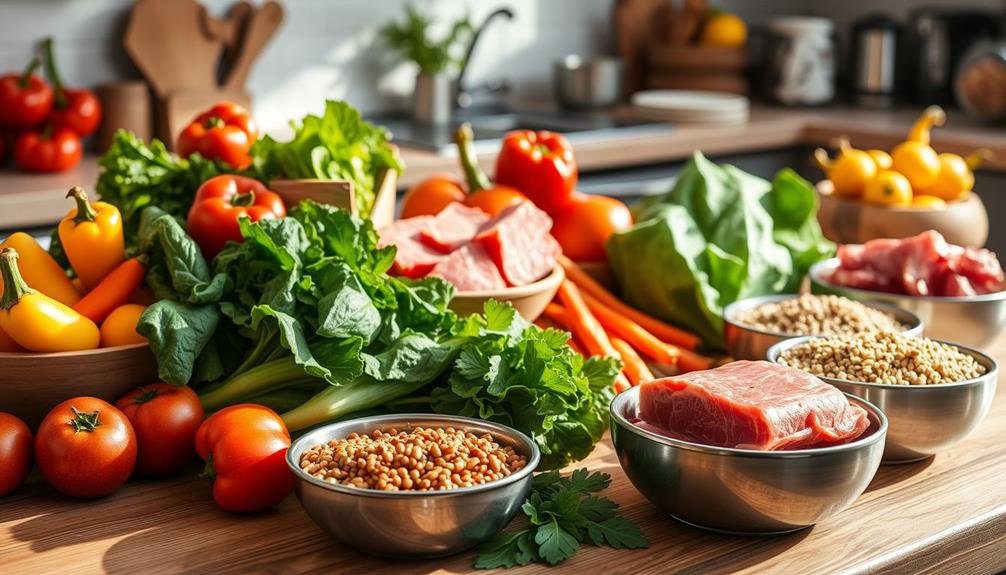
The quality of ingredients in your dog's raw food can greatly influence their health and vigor. When selecting raw food, focus on the source and type of ingredients to guarantee your pup gets a balanced diet rich in essential nutrients.
Additionally, maintaining a proper budget for pet food is vital for long-term financial health, especially if you want to invest in common financial terms that can save you money. Here are some key factors to take into account:
- Hormone-free meats: Look for locally sourced options to guarantee freshness and support local agriculture.
- No antibiotics: Choose raw food without antibiotics to promote your dog's health and minimize the risk of antibiotic resistance.
- Additive-free: Avoid raw meals with additives or preservatives, as these can harm your dog's digestion and overall well-being.
- Balanced composition: A proper raw diet should include muscle meat, organ meat, and finely ground bone for thorough nutrient intake.
Additionally, evaluate the reputation of the raw food brand. Opt for companies with transparent sourcing practices and strict quality control measures, assuring the safety and nutritional value of the food.
Factors Influencing Dog's Diet
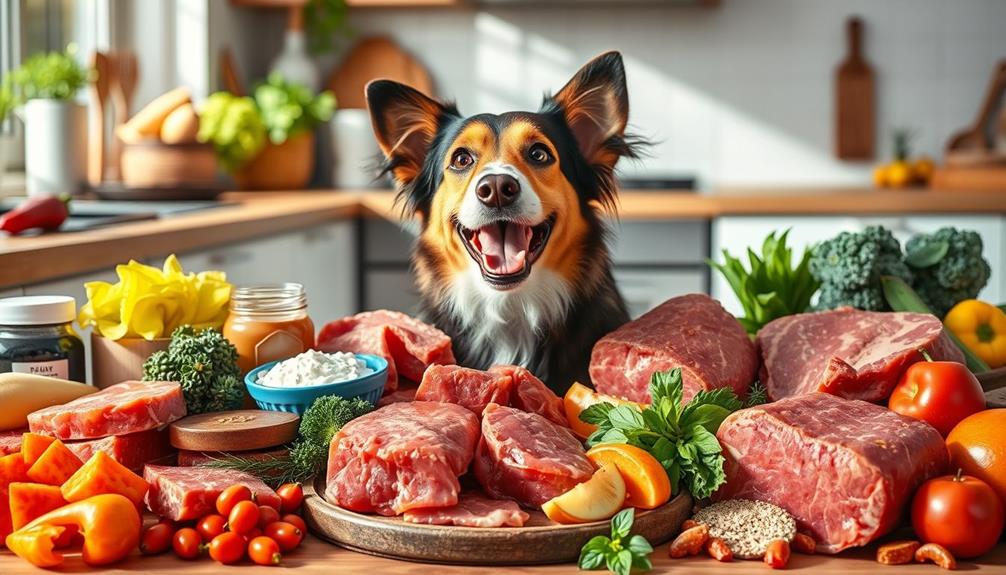
Many factors influence your dog's diet, making it imperative to tailor their feeding plan to their specific needs. Age plays a significant role; for instance, puppies need 2-3 times the food of adult dogs based on their current weight to support growth.
As your dog matures, you'll want to adjust their intake according to their adult weight and activity level. Active dogs often require around 3% of their body weight in food, while those at an ideal weight typically need 2-2.5%.
Additionally, just as energy-efficient appliances can lower overall energy consumption, understanding your dog's energy needs can help optimize their diet for better health and well-being.
Metabolic rate is another key consideration. Dogs with a higher metabolic rate may need more calories, especially if they're in colder climates, where extra energy is necessary for maintaining body temperature.
Regular monitoring of your dog's weight is essential for proper weight maintenance. If you notice your dog gaining or losing weight, it's time to reassess their food intake.
Always remember, each dog is unique, and adjusting their diet based on these factors will guarantee they stay healthy and active throughout their life. Tailoring their feeding plan is important for their overall well-being.
Feeding Guidelines for Puppies
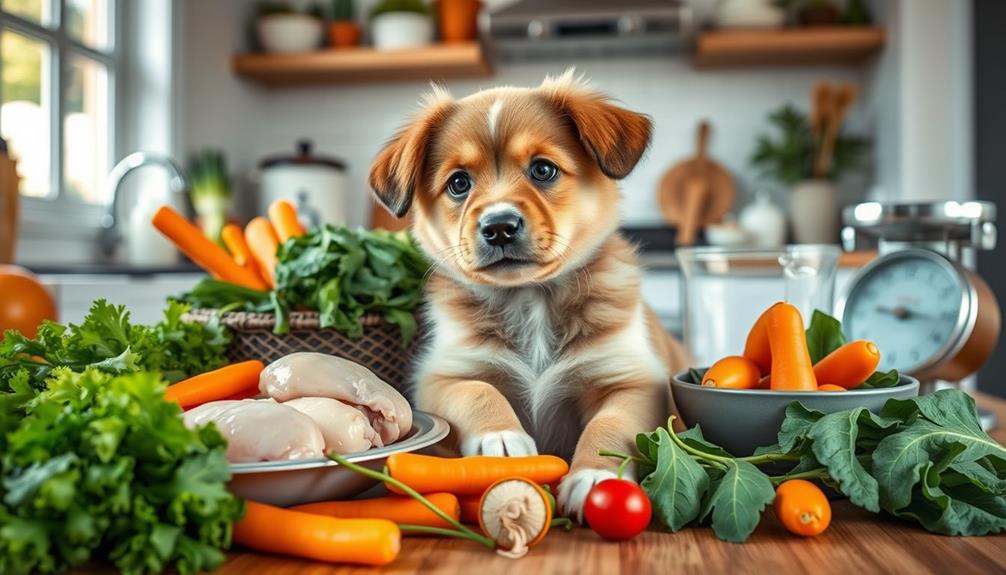
When it comes to feeding puppies, understanding their unique nutritional needs is vital. Puppies require more food than adult dogs—about 2-3 times the amount based on their weight. Aim for a portion size of 10% of their current weight or 2-3% of their ideal adult weight. A balanced diet rich in specific nutrients is essential for their healthy growth and development, as it supports overall health and longevity lifestyle for longevity.
Here's how to structure their feeding routine:
- Very young puppies should be fed 3-4 times a day.
- Older puppies thrive on twice-daily feedings.
- Monitor their growth closely to adjust food quantity as needed.
- Consider adding nutritional supplements like fish oil or probiotics to support development.
A well-balanced raw food diet is particularly beneficial for puppies of specific breeds, such as Dachshunds. This approach can help promote healthy weight management, energy levels, joint health, and coat condition.
Always remember that each puppy is unique, so tailor their diet to accommodate their age, weight, and breed. By following these guidelines, you'll guarantee your puppy grows up healthy and strong, setting a solid foundation for their future.
Transitioning to Raw Dog Food
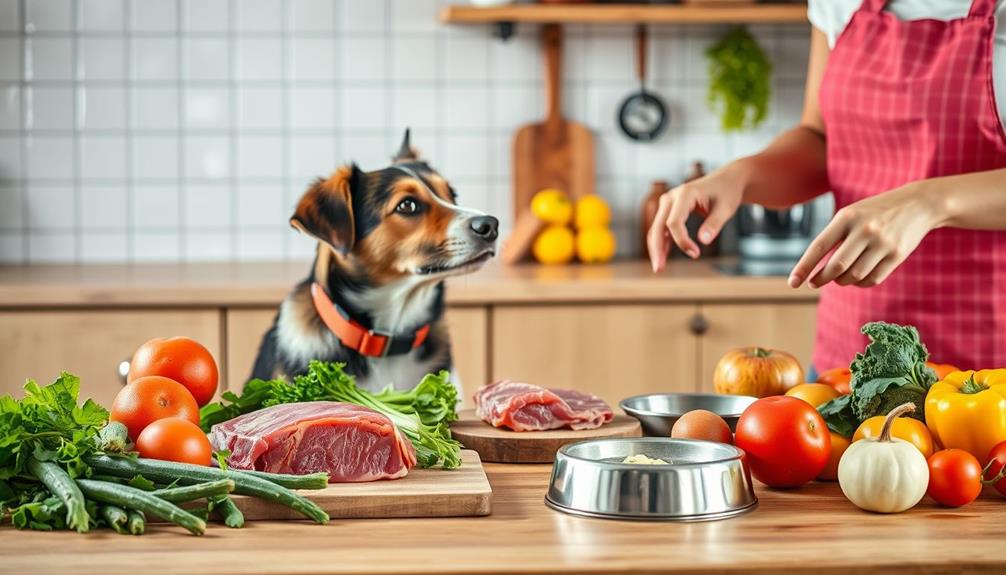
Changing your dog to a raw food diet can be a rewarding journey, but it requires careful planning to guarantee a smooth alteration. Start shifting to raw dog food over a 13-day period, beginning with 25% raw food and 75% of their current diet for the first four days.
From Days 5 to 8, adjust the ratio to 50% raw and 50% old food. During this time, be aware of any dietary considerations, such as pet food safety, to secure your dog's health is prioritized.
Then, from Days 9 to 12, move to 75% raw and 25% old food, finally reaching 100% raw on Day 13.
If your dog is a picky eater or has a sensitive stomach, consider extending each step of the shift by a few days. During this process, it's essential to monitor your dog's stool quality and overall behavior.
Keeping an eye on how they respond will help you ascertain they're adjusting well to this new balanced diet.
Using a raw feeding calculator can also help determine the right amount of food for your dog's size and activity level, making the adjustment smoother.
With patience and attention, you'll set your dog up for a healthier, happier life with raw food.
Raw Dog Food Calculator
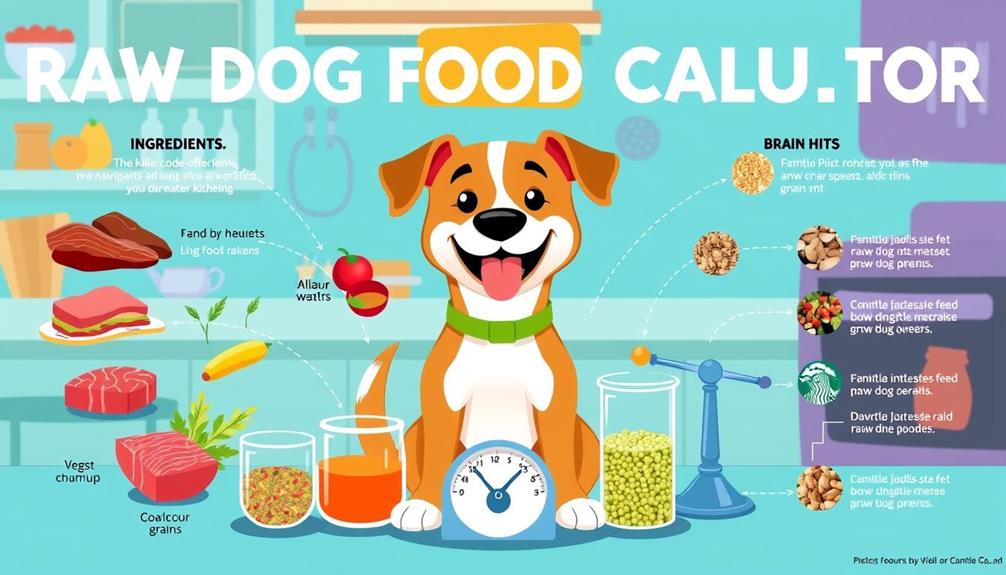
Using a raw dog food calculator is a practical way to guarantee you're feeding your dog the right amount of food. This tool helps you calculate the appropriate amount of raw dog food based on your dog's weight and dietary needs.
Generally, for maintenance, you should feed your adult dog about 2% to 3% of their ideal body weight daily. Adjustments may be necessary based on your dog's activity level and individual health needs.
Here are some key factors the calculator considers:
- Input your dog's weight in pounds.
- Select the percentage of their diet that will consist of raw food (10%-100%).
- Smaller dogs often require a higher percentage of their body weight than larger dogs.
- Regular monitoring of your dog's health and weight management goals is essential.
Safe Handling and Serving Instructions
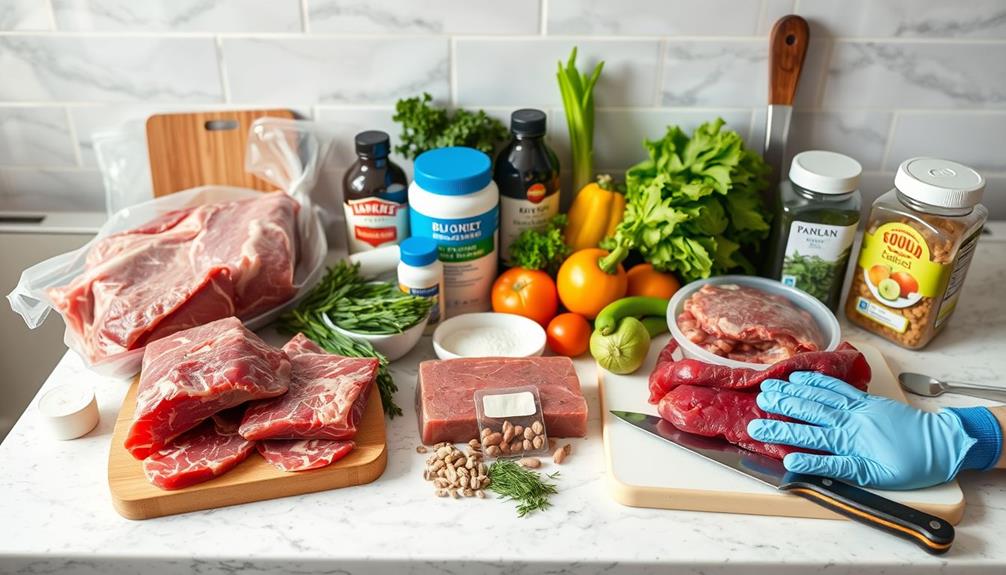
Handling raw dog food safely is essential to preventing foodborne illnesses for both you and your pet. Start by purchasing raw dog food in 2lb or 5lb frozen chub packs.
Always thaw the food gradually in the refrigerator to maintain safety and quality. Once thawed, use it within 72 hours, or you can repackage and refreeze it within 24 hours to prevent spoilage.
During preparation, keep raw meat separate from other foods to avoid cross-contamination. Use designated cutting boards and utensils specifically for raw food. This minimizes the risk of contaminating other ingredients.
After handling raw dog food, thoroughly clean all surfaces, utensils, and your hands to eliminate any potential bacteria. Maintaining hygiene is vital in ensuring the health of both you and your dog.
Incorporate these safe handling practices each time you serve raw food to your pet, and you'll greatly reduce the risk of foodborne illnesses. Remember, a little diligence goes a long way in keeping your furry friend healthy and happy.
Following these guidelines will help you provide the best raw diet for your dog while ensuring safety at home.
Frequently Asked Questions
How Much Raw Food Should I Feed My Dog Chart?
To determine how much raw food you should feed your dog, use a feeding chart based on their weight, activity level, and age. Adjust portions accordingly, ensuring they get the right nutrients for their needs.
What Is the 80 10 10 Rule for Raw Dog Food?
Think of a balanced meal as a colorful palette. The 80/10/10 rule for raw dog food suggests you paint your dog's diet with 80% muscle meat, 10% organ meat, and 10% bone for vibrant health.
What Is the Best Raw Food Ratio for Dogs?
To determine the best raw food ratio for your dog, consider their weight, activity level, and age. Typically, adult dogs need 2-4%, while puppies require 5-10% of their body weight daily for peak health.
What Are the Proportions for Raw Dog Food?
Think of your dog's diet like a well-tuned instrument! For raw food, aim for 2-3% of their ideal body weight daily, adjusting based on their activity and health needs for peak nutrition.
Conclusion
In summary, switching your dog to a raw diet can lead to a healthier, happier pet, with studies showing that 70% of dog owners report improved energy levels and coat condition in their furry friends. By understanding portion guidelines and ensuring high-quality ingredients, you can make this change smoothly. Remember to take your time and adjust based on your dog's needs. Embrace the journey to better health for your canine companion—you'll both reap the rewards!

